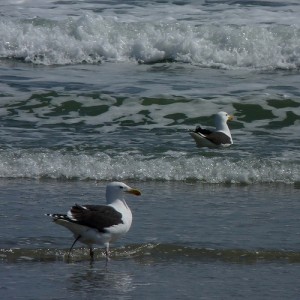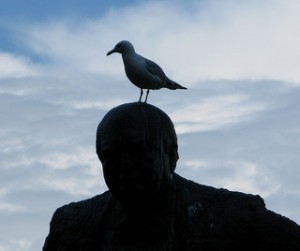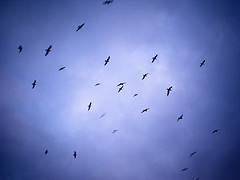 I have been trying to discourage my older son from chasing birds. For a while it worked—he couldn’t say much and was easily distracted by food (a family flaw). But now he’s a better conversationalist than I am, and of course the first thing he asks is, “Why?”
I have been trying to discourage my older son from chasing birds. For a while it worked—he couldn’t say much and was easily distracted by food (a family flaw). But now he’s a better conversationalist than I am, and of course the first thing he asks is, “Why?”
I tried to explain something about how it can stress the birds—when you see a group of already-skittery sanderlings speed up their tiny feet, it makes your own heart pound—and then that can make them not do very well. This does not sound very convincing in my sleep-deprived vocabulary.
The birds that we see the most on our beaches are gulls. I have to confess I’m not ever sure of the species—I took a wildlife class in college, which mostly consisted of bird identification, but even our avid birder professor said he didn’t expect us to keep gulls straight.
(Okay, I got embarrassed after I wrote this, so I ran down to the beach and came back to check my bird book. I saw Western gull, Heerman’s gull, long-billed curlew, and marbled godwit. A curlew took a poop right in the surf zone while I watched, which actually gets me to where I was trying to go: bird poop.)
 I’ve gotten splattered only a few times—not my favorite, but I didn’t think about much more than the messy cleanup until I started reading about what happens when there’s a lot of gulls.
I’ve gotten splattered only a few times—not my favorite, but I didn’t think about much more than the messy cleanup until I started reading about what happens when there’s a lot of gulls.
With lots of gulls, you can get lots of poop—and this can seriously affect water quality. Fun stuff like E. coli and Salmonella has been found in gull droppings.
Last year, researchers who found E. coli in gull splatter in Portugal also found that some of the E. coli had genes that could confer drug resistance. (In fact, some have started wondering if the gull is a culprit in the spread of drug-resistant bacteria.)
So what to do? One recent study looked at putting corn oil on eggs to start dropping the size of nesting populations near Chicago’s Lake Michigan beaches (and found that more beaches every year scored better on water quality). But adult gulls still used the beaches (and call me soft-hearted, but the idea of oiling an egg sounds like a real bummer).
A long time ago, I did a story about programs that use falcons to scare off smaller birds near airports in order to prevent bird strikes. It seems that people also use falcons to scare off gulls wherever they gather—landfills, beaches, even the outdoor dining areas of fancy hotels (stay away from my $15 organic sweet potato fries!).
Falconry has actually helped with water quality in some places. Tajiguas, a landfill in Santa Barbara County, used to have gulls wheeling overhead by the thousands. And its neighbor, Arroyo Quemado beach, made hit lists of dirty Southern California beaches (in fact, it was the absolute filthiest in 2001).
But once falcons started patrolling the skies above the dump in 2002, only a handful of gulls remained, and water quality at the beach quickly moved toward good health. (And the dump’s workers could use their time moving around trash, rather than scraping corrosive poop from their equipment.)
Landfills around the country—even ones not near the beach—have started using falcons to keep gulls away. Last October, gulls swarmed a Portland, Oregon transfer station. The station had been picking up food scraps from restaurants since 2004, and was due to start a residential program, too. The transfer station brought in a falconry company, whose charges generally harass gulls (although in the Oregonian article linked above, the falcon on duty kills a gull and gets a “time out” from his handler.)
Orange County’s Poche Beach, which often has extremely high bacteria levels, is also getting the predator treatment. Here, the water is often so dirty that officials can’t get a good read on water coming from a nearby purification plant.
Avian predators aren’t the only ones on beach cleanup duty. A study last month in Environmental Science & Technology compared water samples from a Lake Michigan beach before and after a trained dog team entered the scene.
Before the dogs’ arrival, they found pathogens like Salmonella and Campylobacter; once the dogs had done nine days of patrol, neither of these baddies were present. E. coli and Enterococcus levels were much lower, too.
After reading Erik Vance’s post about using Jack Russell terriers to deal with Yosemite’s little hantavirus problem got me thinking that there’s another predator that can deal with gulls: the wild toddler. I know I’ll have at least one volunteer.
Bonus: Here’s a video of a falconer at Tajiguas.
**
Images from Flickr users: Top: Dendroica cerulia Middle: leeno Bottom: angies
One thought on “Poo Fighters”
Comments are closed.